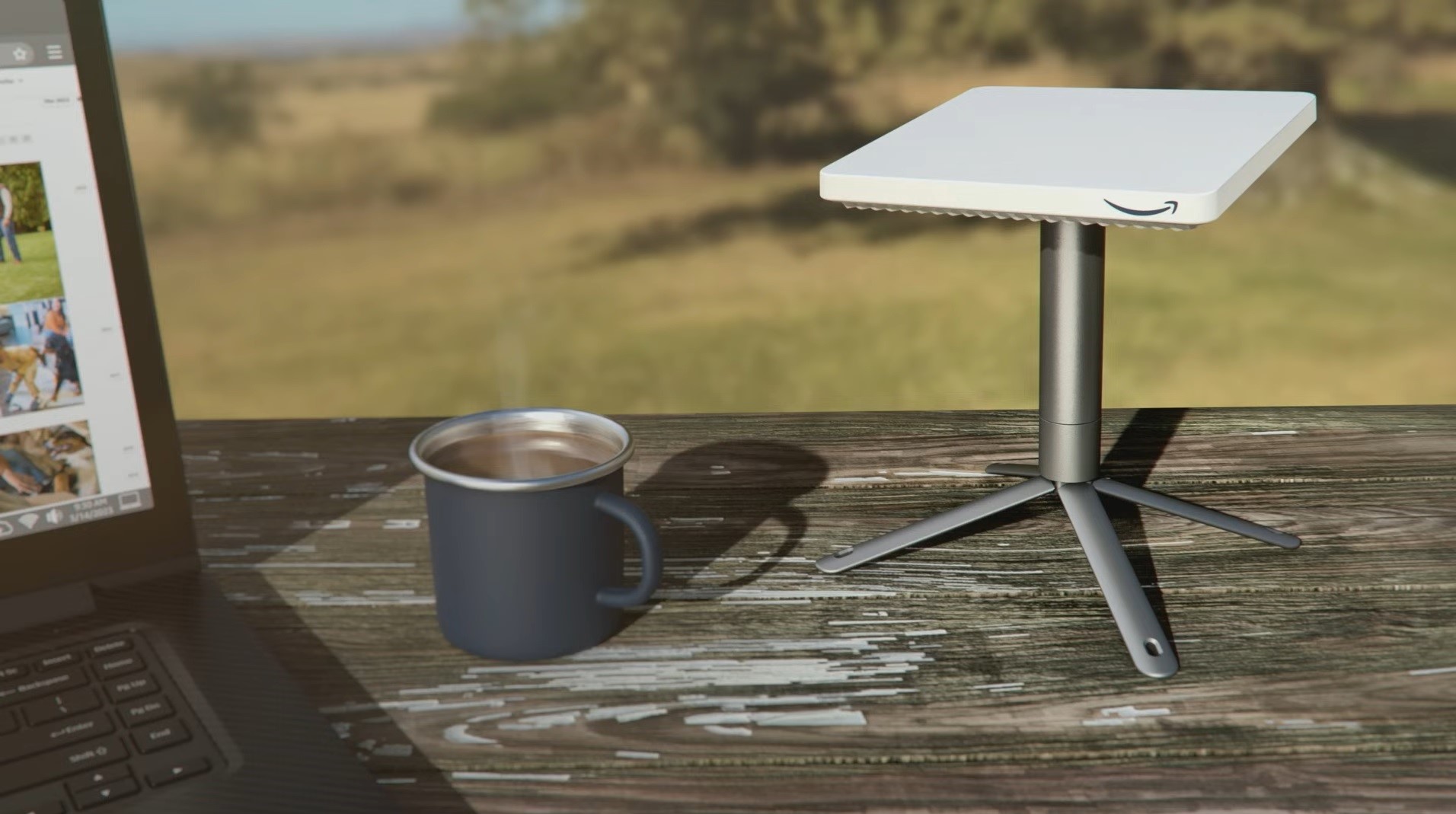
After years of development, Amazon is showing off the antennas it plans to use for its Project Kuiper satellite broadband network — and says it plans to begin offering beta service for large customers next year.
The largest antenna, for enterprise customers, is about the size of a café table. The antenna designed for home use is as big as an LP record’s album sleeve and should cost around $400 to make. The smallest antenna, still under development, is just a little bigger than an ebook reader.
“I’d be remiss if I didn’t contrast it to a Kindle here,” said Dave Limp, Amazon’s senior vice president of devices and services, who helpfully made the comparison today during the big reveal at the Satellite 2023 conference in Washington, D.C.
Amazon hasn’t yet launched any of the 3,236 satellites for the constellation it plans to operate in low Earth orbit — and it’s far behind SpaceX, which says it already has more than a million customers for its Starlink broadband service. But Limp insisted that Amazon was in position to make rapid progress over the next year.
He noted that the first two prototype Kuiper satellites have just been shipped to Florida, in preparation for launch aboard a United Launch Alliance Vulcan Centaur rocket this spring. And he said multiple satellites should be ready for liftoff by next year. The Kuiper operation is headquartered in Redmond, Wash. — not far from SpaceX’s satellite factory — and Amazon plans to start mass-producing satellites at a factory in Kirkland, Wash., by the end of the year.
Limp said Amazon was on track to launch half of the satellites for the Kuiper constellation by mid-2026, using up to 77 medium- to heavy-lift rockets it’s reserved at ULA as well as at Arianespace and Blue Origin. (Amazon founder Jeff Bezos owns Blue Origin as a separate, privately held space venture.)
“For sure we will be beta-testing with large customers in ’24,” Limp said.

In a sense, Limp’s fireside chat at Satellite 2023 was a coming-out party for Amazon’s Kuiper plans. “We haven’t been able to say this for the last four years, but you can kind of consider us open for business,” he told the industry crowd.
In a blog posting, Amazon laid out the details for its satellite terminals. The standard customer antenna will be less than 11 inches square and 1 inch thick. It’ll weigh less than 5 pounds without its mounting bracket, but should be capable of delivering network speeds of up to 400 megabits per second. The anticipated manufacturing cost? Less than $400 per terminal. Starlink’s terminals currently sell for $599.
Kuiper’s largest antenna — meant for enterprise, government and telecommunications applications — will measure 19 by 30 inches and deliver speeds of up to 1 gigabit per second, Amazon says.
The smallest terminal is still under development. “The team didn’t want to do this, but we’re going to do it anyway,” Limp joked as he pulled a prototype out of an Amazon shipping envelope. That ultra-compact terminal will weigh a pound, offer speeds of up to 100 megabits per second, and cost less than the standard model.



Like SpaceX, Amazon aims to provide high-speed internet service to potentially hundreds of millions of people who are underserved in the U.S. and around the world.
When Limp was asked how Amazon planned to differentiate its Kuiper service from SpaceX’s Starlink, he pointed to Amazon’s track record of networking prowess (through Amazon Web Services), customer service and the ability to drive down costs at scale.
He also talked up an Amazon-designed processing chip called Prometheus, which will be incorporated into all of Kuiper’s networking equipment.
Prometheus is said to combine the processing power of a 5G modem chip, the capability of a cellular base station to handle massive data traffic flows, and the ability of a microwave backhaul antenna to support point-to-point connections. The chip should make it possible for Kuiper’s satellites and ground gateways to process up to a terabit of data per second.
“This is as close to magic as I know,” Limp said.

Amazon’s business model for Kuiper draws upon synergies with the company’s other market offerings, including AWS’ relationships with companies that rely on broadband networking. Limp pointed out that networking is becoming increasingly cloud-centric, which plays to AWS’ and Kuiper’s strengths.
“As workloads move up into the cloud, they’ll be in data centers, and Amazon has a large number of those,” he said. “By having those workloads close to the Kuiper network, we can [provide] more performance. So if it’s streaming a movie from Netflix, or it’s getting Salesforce data from your enterprise, those workloads are often closely aligned to Amazon Web Services. And our network is going to be substantially the same as what that is.”
Amazon has committed more than $10 billion to Project Kuiper over the coming years, and intends to make a profit when the network is complete. But Limp said Project Kuiper was about doing good as well as building a good business.
“When you see the Venn diagram overlapping between a good business and something that’s good for society, it puts a smile on your face,” he said. “And I think this is a similar kind of business. We have, obviously, a lot to prove out in the next few years. But if we’re successful, it can be a very good large business for Amazon. And I think it can change a lot of consumers’ lives. It can make enterprises more productive, and it can help governments in many different ways. So I think that makes me just in my happy place.”



